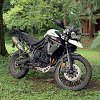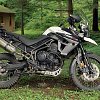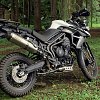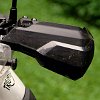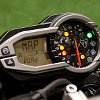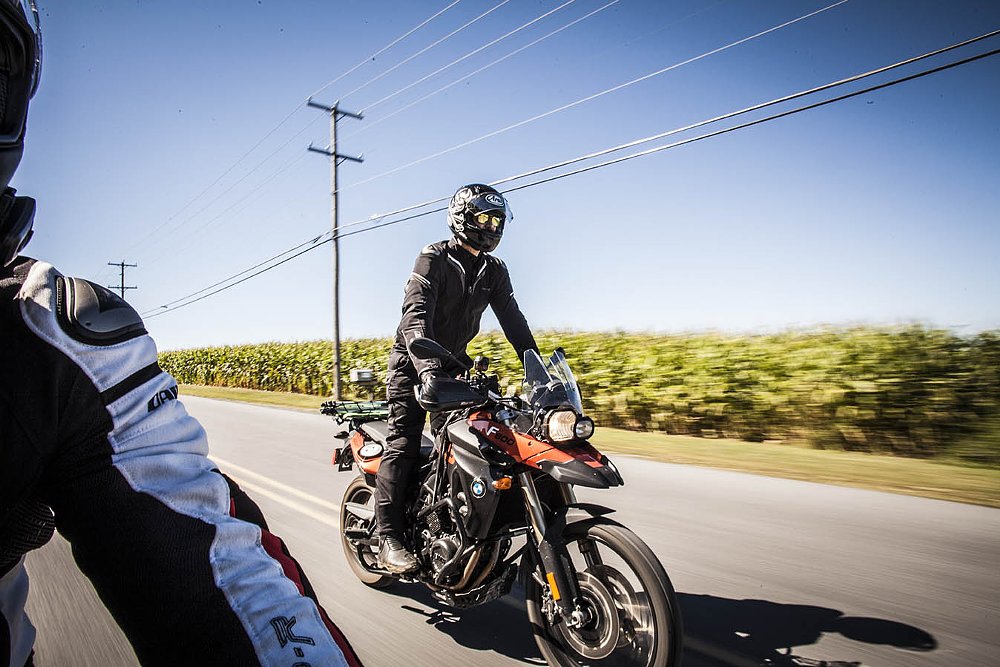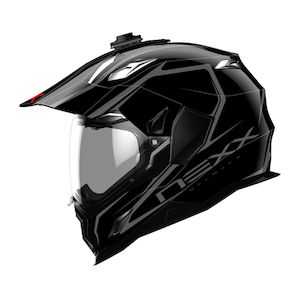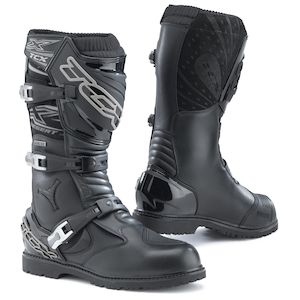“There’s a storm coming,” the woman working at the gas station commented, glancing out the window. Thunderclouds rolled over the distant mountaintop, darkening the landscape. I just nodded as I paid for the gas and a bottle of Gatorade.
Walking back to the pump, a 2015 Triumph Tiger 800 XCx waited patiently while I happily donned my neon-yellow raingear. A little rain wasn’t going to kill my mood.
I was covered in mud and sweat after three days testing a long list of upgrades Triumph made to the Tiger for 2015. After logging almost 2,000 miles on the Tiger over a week and a half without seeing rain, I viewed the oncoming storm not as a problem, but as an opportunity to try the rain map on the new electronics package.
The bike
For 2015, the entire Tiger lineup gets a long list of updates and improvements. Without any major changes since its 2010 introduction, the previous generation was getting a bit long in the tooth. The sportier, road-oriented Tiger has been redubbed the Tiger 800 XR while the taller, more dirt-worthy Tiger remains the XC. Both bikes received an updated gearbox, an all-new throttle-by-wire system claimed to improve fuel efficiency by 17 percent and switchable traction control coupled with the updated ABS package. The XC goes one step further with the addition of an adjustable WP suspension designed to tackle duties both on and off the road.

The WP front fork features 8.7 inches of travel and adjustment for compression and rebound damping. This is complemented in the rear by a WP monoshock offering up 8.5 inches of travel with adjustment for hydraulic preload as well as rebound damping. For those of you who are new to the adventure bike world, this is a massive amount of travel that can handle huge bumps and ruts. Despite the long travel, the XC still feels surprisingly planted on the street.
The standard seat height is adjustable between 33.1 inches in the lowest position and 33.9 inches in the highest. For the vertically challenged, there is an available low seat option that drops the seat height to 32.3 inches in the lowest position.

With both the XR and XC, Triumph introduced an “X” version packed with extras, and it was the XCx that I tested. The XCx will set you back $13,499, $1,100 over the standard XC. So what do you get for the extra cash?
The Tiger 800 XCx comes with additional hard parts, such as crash bars, plastic hand guards, an aluminum skid plate, and a center stand. An advanced computer provides information on fuel consumption, hours and miles traveled, and the ability to enable self-canceling turn signals. But the real upgrade is the electronics package. Riders get to choose from three modes: On Road, Off Road, and Rider mode, the last of which is completely programmable. Once in Rider Mode, you can choose from four different throttle maps, Rain, Off-Road, Road, and Sport, ranging from least to most sensitive.

Along with throttle response, riders can also set the level of interference from the ABS and traction control system to On, Off-Road, or Off. The upgraded electronics package on the XCx also incorporates electronic cruise control, thus making long-haul highway miles a breeze.
Amid all of these changes, the one constant across the Tiger lineup is the DOHC, 12-valve, 799 cc inline-triple engine that set its predecessor apart from the crowd. The engine pulls relatively strong throughout the entire rev range, but things really start getting fun above 5,500 rpm, with a peak of 58 foot-pounds of torque at 7,850 rpm and 94 claimed horsepower at 9,250 rpm.

Twin 308 mm rotors and Nissin, two-piston brake calipers slow the front 21-inch wheel, while the 17-inch rim on the back is halted by a single-piston Nissin caliper clamping down on a 255 mm rotor. Brake feel was solid and predictable with slight fade over time. The wheels were wearing Bridgestone Battle Wing tires when I first picked up the bike, a 90/90-21 up front and a 150/70-17 in the rear, but those didn’t last long. We’ll talk more about that a little later on.
Testing the Tiger
I racked up a ton of miles on this bike over the 10 days it lived in my garage. My goal was to put the Tiger 800 XCx through its paces in a variety of environments that mimicked its intended habitat.

I picked up the bike on a Thursday afternoon and within 24 hours I was off for the weekend, armed with a tent and heading north to the Catskills. The fastest way out of Philadelphia is to hit the Pennsylvania Turnpike and the Tiger handled the hour and a half of highway duty with ease. The electronic cruise control was a welcome addition and worked absolutely flawlessly.
Looping through the backwoods of northern New Jersey, I crossed into New York through Port Jervis. I filled my days riding winding back roads and romping down light dirt stretches, and then camped alongside mountain streams and fell asleep under the stars. By the time I was back in Philadelphia on Monday morning, I had logged almost 1,000 miles in just over 48 hours and couldn’t have been more comfortable.

One thing was made clear on this initial trip: If I was going to tackle anything more aggressive than a dirt road, I was going to need different tires. I ordered up a set of Mitas E-07 tires and spent the rest of the week using the Tiger for commuting to the office.
The WP suspension capably handled the bombed-out, pothole-laden streets of Philadelphia. The Givi-built, Triumph-branded aluminum panniers are an option that will set you back about $1,350 for bags and mounts if you buy them at your Triumph dealer, but they made storage for the daily commute extremely simple. The Tiger proved to be an excellent urban commuter.

Gearing up for the following weekend’s shoot, I stripped the bike of said luggage, installed the Mitas E-07s, and set out with the RevZilla video team to Bald Eagle Mountain, the site of AltRider’s annual “Conserve the Ride” event. With promises of beer, a pig roast, and excellent on- and off-road riding opportunities, we couldn’t think of a better location to put the new Tiger 800 XCx to the test. Over the next three days, I tackled everything from twisted pavement, to dirt roads, gnarly dual-track treks and even some light single-track trails.

Highlights
Shooting the video for the Tiger, I was trying to figure out a way to describe the engine that would convey the emotion it elicits. I kept coming back to a line from a Jason Isbell song where he describes a man in the prime of his life as having a “vandal’s smile.” Remember a time in your life when you were a little wilder at heart and lacking the responsibilities that come with age? This engine tugs on that part of your past. It brings a vandal’s smile to your face.
It’s not that the Tiger 800 offers more power than any other bike out there. It barely breaks 90 claimed ponies. But the power is accessible. You can wind the throttle out and actually play in the powerband without being out of control. It’s balanced and usable both on road and off. I had no problem riding this bike fully loaded with a passenger.

In addition to the engine, it bears mentioning that the new revised gearbox is the smoothest I have ever used on a Triumph. Traditionally, Triumph gearboxes have been known to be a bit clunky. It only took two minutes of riding this new Tiger to notice how smoothly it clicks through the gears.
The new WP suspension is a huge upgrade over the old Showa setup. WP has been owned by KTM since 1999 and this new Tiger XCx benefits from the years of R&D KTM has invested in developing dual-sport suspensions.

All said and done, it was the Tiger’s new throttle-by-wire system that surprised me the most. I had used the older version of this on the Trophy 1200 and Tiger Explorer and I absolutely hated it. With the Tiger 800 XCx, the new throttle eliminates all but a hint of the on-off response plaguing most modern bikes. I found that while it did take a little while to get used to the overall feel, in the end I appreciated the different rider modes and throttle maps allowing me to fine-tune how I wanted the bike to respond.
The ABS was an improvement over previous Triumphs I have ridden. In Off-Road mode, the ABS is completely disabled at the rear wheel with limited engagement up front and worked well to stop the bike in the dirt. Traction control in Off-Road mode allows for limited slip, helping to give riders new to the dirt a bit more confidence. I found that when I was riding off-road, I preferred to turn the traction control all the way off, allowing for complete wheel slip (especially if you are planning to have the wheels off the ground) while leaving ABS partially engaged in Off-Road mode.

Riding the 487-pound Tiger in serious off-road environments reminded me not to confuse it with smaller, more dirt-oriented options. However, the upgraded suspension, programmable throttle maps, and varying off-road settings for ABS and traction control vastly improve this new Tiger’s off-road prowess over the previous generation.
Lowlights
So I am a bit old-fashioned in my mindset and the addition of all of these new electronic options makes me a little uncomfortable in a “the machines are learning” kind of way. Hell, I still drive a car lacking ABS.
The upgraded electronics on the “X” package do a great job of helping the rider control the bike, both on road as well as off, but the user interface is confusing and counterintuitive. The icons are small and hard to read and the hand controls are hard to use while riding. For example, I have to reach across the starter button to engage cruise control and it’s hard to do so without removing my hand from the throttle, and this coming from a guy with big hands. In addition, if you have the bike set up for off-road use with either ABS or traction control completely disabled, it automatically reverts to Road Mode when you shut off the bike. This threw me for a loop a few times when I was off-road, expecting to spin the rear wheel and the traction control kicked in hard, throwing me completely off balance.

In addition to the electronics package, another advantage of the throttle-by-wire system, according to Triumph, is an increase of 17 percent efficiency in fuel consumption over the previous model. Triumph’s published fuel numbers for this bike are 59 mpg city, 77 mpg on the highway at 56 mph, and 53 mpg highway at 75 mph, for up to 272 miles per tank. The closest I came to hitting these numbers was averaging 49 mpg and breaking 200 miles on one tank of fuel, barely. While I think 49 mpg is admirable for a fully loaded bike with a 215-pound rider, it still bears a mention that the Tiger fell short of Triumph’s claims in my case.

All of those sensors and systems also add to the weight. The XCx is up 13 pounds from last year’s XC, coming in at 487 pounds topped off with fluids. One could argue that some of the additional weight has to do with the added protection package. That’s all well and good, but I wish the protection were a bit more substantial. The crash bars only cover the bottom half of the engine, the skid plate doesn’t protect the rear shock mount, and the hand guards are the same plastic ones you’ll find on the XRx. With the XCx aimed at a dirtier audience, I would like to see more from this protection package.

Along with the protection, I was disappointed with Triumph’s tire selection for this bike. The Bridgestone Battle Wings this bike ships with have absolutely no place on a dual-sport bike. In the Bear Grylls ads Triumph has been plastering all over the place, the XCx is depicted with Metzeler Karoo 3 tires, an acceptable tire for a bike intended to spend at least a portion of its life off-road.
While I am a fan of the new WP suspension, when I first got the bike, it was set to Triumph’s recommendations for a solo rider. Apparently, solo riders in England aren’t six feet, three inches tall and pushing 215 pounds. I made adjustments to fine tune the settings and I will say that the rear shock could benefit from an easier-to-use remote preload adjuster.

Before we move on to discussing competition, it is important to remember that the biggest issue with the Tiger’s weight is where it’s worn. On paper, it doesn’t look much heavier than its direct competitor, the BMW F 800 GS, but the F 800 has a gas tank which sits below the seat, thus lowering the center of gravity and making the bike feel lighter. With the Tiger’s weight up high, you have to muscle it around quite a bit more to get it to perform as well off-road.
The competition
BMW and KTM have long been the leaders in the world of big adventure bikes. Despite rumors that KTM will introduce a smaller adventure bike to compete against the current middleweights, as of 2015 there are only two dogs in this fight.
The direct competition for the Triumph XCx is clearly the BMW F 800 GS. When similarly outfitted with accessories, the F 800 GS costs roughly $14,000, in the same range as the Tiger 800 XCx’s $13,499. Traditionally, the F 800 GS has outshined the Tiger in the dirt while the Tiger has excelled on the pavement. I have spent the past six months logging miles on RevZilla’s F 800 GS and it feels like a giant dirt bike, whereas the Tiger feels like a tall street bike. Triumph’s main goal with these updates was to get closer to the off-road performance of the BMW while further improving the Tiger’s street pedigree, and they succeeded.

Some could argue that the Suzuki V-Strom 650XT could be considered middleweight competition for the Tiger 800 XCx, as well. With an MSRP of $8,499, it is considerably cheaper than the Tiger, and for that reason alone it’s worth considering. However, it also has less power, less torque, and fewer features. With a 19-inch front wheel, ABS that can’t be disabled, and a lesser suspension, this bike can’t really compete with the Tiger’s performance off-road — or on, for that matter. While the Suzuki is a great little bike with a legion of followers, it’s outmatched going up against the 800 XCx.
Of course, depending on what kind of riding you like, competition could come from either smaller or larger bikes. For riders looking to tackle more challenging terrain off-road with less of a consideration for on-road performance, smaller dual-sports could come into play. Thumpers like Suzuki’s DR650, Honda’s XR650, Kawasaki’s KLR650, and KTM’s 690 Enduro R range from $6,499 for the DR up to a whopping $10,499 for the KTM. For riders looking for larger, more powerful bikes, BMW has the R 1200 GS, KTM has the 1190 Adventure R, Triumph has the Tiger Explorer XC, and Yamaha has the Ténéré. MSRPs for these bikes start above $15,000 and go up from there.
Conclusion
At the end of the day, the Tiger proved to be a competent, do-anything machine. It was so easy to head out to the garage and just take off. I took a few passengers for rides and they all commented about the pillion comfort, as well as the amount of room they had. With the convenience of the aluminum panniers, I found myself using it for trips around town to run errands instead of taking the car. I had a blast trying not to crash in the dirt and carving the corners on the pavement. In the 10 days I had the Tiger, I logged just over 1,950 miles on every type of terrain, smiling the entire time.

Triumph hasn’t entirely closed the gap against the F 800 GS in off-road performance, but they have gotten a lot closer with this new XCx. Additionally, they have taken a bike already known for its on-road prowess and made it even more capable with the addition of electronic cruise control and a suspension that can be tuned to better match the intended terrain. While any dual-sport bike is a compromise, the Tiger 800 XCx does an amazing job blending two separate worlds into one hell of a ride.
I spent the last four hours with the Tiger 800 XCx riding back to Philadelphia in the blinding thunderstorm the woman warned me about. Adventure comes in many forms, and with the Rain Map selected I tore down the highway grinning at all the dry passengers in surrounding cars. How bored they must be.































 Riders Preferred Membership
Riders Preferred Membership

